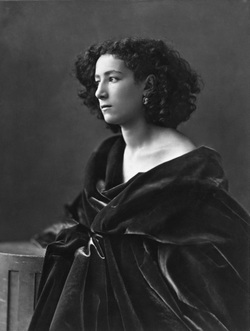 Portrait of Sarah Bernhardt (1864) source: wikimedia
Portrait of Sarah Bernhardt (1864) source: wikimedia While researching the Durant family for the second novel in my series, I came across a reference to Bernhardt in the court testimony of the trial: Heloise (Ella) Durant Rose vs. William West Durant (1903). Ella sued her brother for an accounting of how he had spent the money gained from the sale of their father's Adirondack Railway company and some 1/2 million acres of land in New York State.
On cross examination Ella was asked more than once if she was associated with Sarah Bernhardt and her theater entourage while she lived in London from 1885-1892. This was an obvious ploy to detract from the main intention of Ella's lawsuit: her brother's mishandling of her affairs while holding her power of attorney. However, it may also been true that Ella was palling around with the theater set. In fact, when William visited London in 1889, Ella invited Monsieur Pierre Berton to dine with her and her brother at the Hotel Savoy. William was fit to be tied when he realized that Ella's dinner companion was Sarah Bernhardt's one-time lover and actor in Bernhardt's theater troupe.
One could hardly blame Ella for enjoying the company of thespians. It must have been exciting to be living in London in the late 1880s and to associate with artists that had similar interests as her: writing and producing plays. Ella was after all working on her own play: Dante: a Dramatic Poem which was published in 1889. Although I have not found references to Sarah Bernhardt in any of the scant collection of Ella Durant's correspondence housed at Syracuse University, I did find a number of letters from Lady Anne Thackeray Ritchie, part of the literary scene of London at the time.
William's reaction to Ella's choice of friends, and his lawyer's use of this association against her, may have seemed trite when the issue came up at the trial. By 1903 Sarah Bernhardt was an international star. But when she first arrived in America in 1881-82 to put on Camille at the Booth Theater in New York City, the American critics were scandalized. Maybe it was the plot: a story about a French courtesan. Or it may have been the American's audience lack of understanding of French theater. Either way, as typical American fashion, the more scandalous the topic, the more attracted people were to the story. Bernhardt became an over night sensation, so much so that the American press made fun of prudish Queen Victoria for refusing to the allow the play to be shown in London. That ban didn't last long either.
Sarah Bernhardt was a trendsetter. When she came to America she enthralled wealthy industrialists like the Vanderbilt men, supposedly procuring the handkerchief used by one of them to cry into during her production, and framing it. She had many lovers, including royalty. She became so popular that women copied her style. When she wore an ostrich feather in her cap, other women followed suit. When she wore gloves up the length of her arms to hide her bony structure, other women did also, bony arms or not. It was said she was tempestuous, and not afraid to tell people, including Prince Napoleon and the Prince of Wales, what she thought of them if she felt they were rude toward her. Yet she remained famous. She was given gifts of jewels by her many male admirers and made millions from her fame, especially in America.
The only other reference I have to associate Ella Durant with Sarah Bernhardt is a mysterious Count de la Salle. In the court testimony, William's lawyers question Ella about her money lending to this Count from Paris. Again they insinuate a connection to Sarah Bernhardt, asking Ella if the Count was in the same social set. In my reading about Sarah Bernhardt I can find nothing about a Count de la Salle. I am still looking for any references about this man for my second novel in the Durant family saga. While doing so I get to read about the likes of Sarah Bernhardt, and imagine what it was like if Ella was to meet her after a performance of Camille in London.
 RSS Feed
RSS Feed
